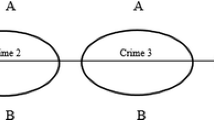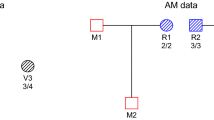Abstract
Forensic DNA expertise is conventionally used to link, within a criminal case, a genetic profile found on a crime scene to the genetic profile of a known individual (for example, a suspect). DNA databases extend that logic across cases. By storing genetic profiles from different cases in such a database we can link cases that concern the same genetic profile (that is, the same individual) with each other. Although these are the two main approaches to exploiting forensic DNA, more forensic intelligence can be derived from databases containing genetic profiles. In this study, we explore the idea that different individuals can be linked to each other because their genetic profiles have been found on the same crime scenes, hereby forming DNA-based networks of individuals. To demonstrate that idea, data from the National DNA database of Belgium is analysed. The findings concern more than 400 networks, characterized in terms of size, geographical locations and types of crime. The potential of this forensic intelligence to support the Belgian judicial authorities and law enforcement in their missions is discussed.




Similar content being viewed by others
References
Ball, L. (2013) Automating social network analysis: A power tool for counter-terrorism. Security Journal. doi: 10.1057/sj.2013.3.
Csárdi, G. and Nepusz, T. (2006) The igraph software package for complex network research. Interjournal, Complex Systems, http://www.Igraph.Org.
Gill, P. and Buckleton, J. (2004) Biological basis For DNA evidence. In: J. Buckleton, C. Triggs and S. Walsh (eds.) Forensic DNA Evidence Interpretation. Boca Raton: CRC Press.
Jeffreys, A.J., Wilson, V. and Thein, S.L. (1985) Hypervariable ‘minisatellite’ regions in human DNA. Nature 314(6006): 67–73.
Kolaczyk, E. and Csárdi, G. (2014) Statistical Analysis of Network Data With R. New York: Springer.
Lammers, M. and Bernasco, W. (2013) Are mobile offenders less likely to be caught? The influence of the geographical dispersion of serial offenders’ crime locations on their probability of arrest. European Journal of Criminology 10(2): 168–186.
Lammers, M., Bernasco, W. and Elffers, H. (2012) How long do offenders escape arrest? Using DNA traces to analyse when serial offenders are caught. Journal of Investigative Psychology and Offender Profiling 9(1): 13–29.
Malm, A., Bichler, G. and Van De Walle, S. (2010) Comparing the ties that bind criminal networks: Is blood thicker than water? Security Journal 23(1): 52–74.
Malm, A.E., Kinney, J.B. and Pollard, N.R. (2008) Social network and distance correlates of criminal associates involved in illicit drug production. Security Journal 21(1–2): 77–94.
Medina, R.M. (2014) Social network analysis: A case study of the islamist terrorist network. Security Journal 27(1): 97–121.
Moniteur Belge. (1999) Loi Du 22 Mars 1999 Relative À La Procédure D’identification Par Analyse ADN En Matière Pénale.
Moniteur Belge. (2001) Arrêté Royal Portant Exécution De La Loi Du 8 Décembre 1992 Relative À La Protection De La Vie Privée À L’égard Des Traitements De Données À Caractère Personnel.
Moniteur Belge. (2002) Arrêté Royal Du 4 Février 2002 Pris En Exécution De La Loi Du 22 Mars 1999 Relative À La Procédure D’identification Par Analyse ADN En Matière Pénale.
Moniteur Belge. (2011) Loi Modifiant Le Code D’instruction Criminelle Et La Loi Du 22 Mars 1999 Relative À La Procédure D’identification Par Analyse ADN En Matière Pénale.
Moniteur Belge. (2013) Arrêté Royal Portant Exécution De La Loi Du 22 Mars 1999 Relative À La Procédure D’identification Par Analyse ADN En Matière Pénale Et Fixant La Date D’entrée En Vigueur De La Loi Du 7 Novembre 2011 Modifiant Le Code D’instruction Criminelle Et La Loi Du 22 Mars 1999 Relative À La Procédure D’identification Par Analyse ADN En Matière Pénale.
Morselli, C. (ed.) (2013) Crime and Networks. New York: Routledge.
Nenadic, O. and Greenacre, M. (2007) Correspondence analysis in R, with two- and three-dimensional graphics: The ca package. Journal of Statistical Software 20(3): 1–13.
R Core Team. (2014) R: A language and environment for statistical computing. R Foundation For Statistical Computing, http://www.R-Project.Org.
Renard, B. (2008) Ce Que L’ADN Fait Faire À La Justice. Sociologie Des Traductions Dans L’identification Par Analyse Génétique En Justice Pénale. Ph.D. Dissertation, Criminology, Université Catholique De Louvain.
Renard, B., Duboccage, L., Jeuniaux, P. and Vanvooren, V. (2013) Chronique De Criminologie. Les Banques Nationales De Données Génétiques En Belgique. Un Premier Bilan De 10 Ans D’activité. Revue De Droit Pénal Et De Criminologie 2013(12): 927–961.
Ribaux, O. et al (2010) Intelligence-led crime scene processing. Part I: Forensic intelligence. Forensic Science International 195(1–3): 10–16.
Rossy, Q., Ioset, S., Dessimoz, D. and Ribaux, O. (2013) Integrating forensic information in a crime intelligence database. Forensic Science International 230(1–3): 137–146.
Walsh, S. and Buckleton, J. (2004) DNA Intelligence Databases. In: J. Buckleton, C. Triggs and S. Walsh (eds.) Forensic DNA Evidence Interpretation. CRC Press.
Acknowledgements
The notion of network of genetic profiles originated from Pierre Van Renterghem, Vanessa Vanvooren and Bertrand Renard. Patrick Jeuniaux was responsible for leading the research, which included developing the concept of network, developing the scripts and conducting the statistical analysis. Vanessa Vanvooren and Leen Duboccage made significant contributions to validate the data and interpret the results. We thank the anonymous reviewers and editors for their time and efforts during the review process, Institut Géographique National (IGN) for providing the map of Belgium in electronic format, and the staff of the NDD for their continuous and dedicated assistance with case, data and IT management. Patrick Jeuniaux benefited from the financial support of the Prevention of and Fight against Crime Programme of the Directorate-General Home Affairs of the European Commission through the PIES project ‘The Prüm Implementation, Evaluation, and Strengthening of Forensic DNA Data Exchange’, Project number HOME/2011/ISEC/AG/PRUM/4000002150, Grant agreement number 30-CE-0498536/00-03, The sole responsibility lies with the authors. The Commission is not responsible for any use that may be made of the information contained in this article.

Author information
Authors and Affiliations
Corresponding author
Rights and permissions
About this article
Cite this article
Jeuniaux, P., Duboccage, L., Renard, B. et al. Establishing networks in a forensic DNA database to gain operational and strategic intelligence. Secur J 29, 584–602 (2016). https://doi.org/10.1057/sj.2015.31
Published:
Issue Date:
DOI: https://doi.org/10.1057/sj.2015.31




